


1970
Computer Operator
In May Mom saw how much I liked the computers and so she reached out and talked to the administrative assistant at the computing center. Mom, having worked in the University’s Personnel, knew the administrative assistants in many departments around the University where each department had one “Head Administrative Assistant” who pretty much ran the department. Mom would later become one for the Physics Department. So, Mom called the head administrative assistant at the computing center and asked her if they had any parttime openings for students at the computing center. It turns out they did, and the administrative assistant arranged for me to come in for an interview. The day before the interview I told my boss at Hospital Stores that I would be coming in late next day, something I did occasionally so he didn’t think anything of it. On the day of the interview, I went to the computer center offices on the second floor above the computer room. Mom had told me that administrative assistant name was Barbara, the same as Mom and she would be expecting me. I entered the front office where Barbara was sitting, with a at a desk with her nametag on a plaque in front of her, she was nice, reminded me of mom. Barbara gave me a form to fill out and said that the Director would talk to me shortly. After filling out the form, I went into the Director’s office, quickly looking around seeing, bookcases overflowing with books, computer printouts stacked on his desk, chairs and on the floor. The director was a wizardly looking older man, smallish, with wispy gray thinning hair, he could have played the Wizard of Oz quite well. I handed the form I filled out, he looked it over, asked why I wanted to work at the computing center, and I told him that I had taken the free FORTRAN course twice and really liked it and want to learn more. He seemed to like my answer, asked another question or two and then OK, got up and I followed him out to Barbara’s desk, handing her my form and saying something simple like he will be fine, and then he turned around and went back into his office. Barbara, looked at me and asked when I would like to start. I told Barbara I was currently working at Hospital Stores and needed to tell them, she that shouldn’t be a problem and we set the start date Monday two weeks later. Wow, I was like floating on excitement as I went out to my car to go to work at Hospital Stores but on the way there a dread crept over me, I had to tell Mr. Boulware that I was quitting. I drove a little slower, organization in my mind what I would say. When I arrive at work, I go directly to Mr. Boulware’s office, he had the door open, I stand in the doorway and he looks up and sees me and says “Hello Larry, you need something?” I step into his office, and nervously say “I got another job which starts in two weeks.” Mr. Boulware asks where my new job was at and I tell him the University Computing Center, and he wished me the best of luck at the new job. He was really nice about it, it wasn’t much of a problem for him, he had a student stock clerks come and go all the time, four since I had worked there.
Two weeks later I start at the computing center as a Student Computer Operator, or that is what people called us, me and three or other students that worked there, although my official paperwork said I was a “keypunch trainee”. The first day I entered the office on the second floor where Barbara had me fill out some more paperwork and then led me back, though and office area for the programmers and then a staircase that led down into the middle of the computer room below. As I walked down the open staircase, I could see out over the room filled with a dozen large, refrigerator sized, cabinets, the Mainframe. We waked down the stairs over to the mainframe control station where the head computer operator sat in front of a panel of flickering lights. [photo] Ok, not quite like HAL in 2001 Space Odyssey, but still pretty cool. Barbara introduced me to Jim, a senior operator she said, he would take care of me, telling Jim I was a new student computer operator before she turned and went back upstairs.
Jim was one of several fulltime computer operators, and like many positions at the university, there were levels of operator positions, 1, 2, 3, and senior. There was another student operator working at the time, Mike. Jim passed me off to Mike to show me what I would be doing. Mike was one of those “computer operators” I saw pickup the punch cards and bring out the printouts when I took the FORTRAN class, he said I would start with the punch cards. I follow him on his next trip out to get cards, Mike had me pick up the tray of cards that had just been read into the mainframe and follow him out to the lobby. I felt odd being on the other side of the door with the mainframe. I set the tray on the table, and I picked up the new one with the student programs in it and follow Mike back into the computer room. Mike explained the door was always locked but next time I came they should have key for me.
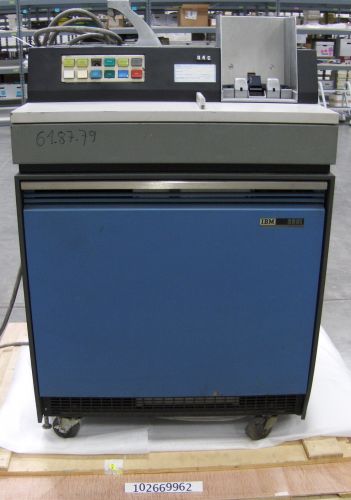 1970
IBM Card Reader
1970
IBM Card Reader
Back in the computer room we go to the card reader, a large desk sized machine, waist high with two hoppers where Mike showed me the process of reading card decks into the mainframe. There would be anywhere from a half dozen to the several dozen student card decks in the tray, each wrapped in rubber bands. Some were small decks like my first program, while others were four, five and even more inches thick. The card decks would be placed to the card hopper on the card reader, you would grab a deck, take off the rubber band, place it in the hopper and then a colored separator card on top, and continued with the next deck of cards until the hopper was full or the tray was empty. The card reader processed cards very fast, it would read a stack of cards six inches high in a few seconds, spitting them out into the output hopper. The objective as an operator was, once started, to keep the card reader input hopper fed with new cards such that it didn’t stop until all the cards were read which wasn’t all that hard if there was only a foot or so of cards that would fit in the hopper, you just stacked them up and pressed go. It was more difficult when there were more cards in the input tray than would fit in the input hopper, once started you would have to keep grabbing cards from the tray, remove rubber bands, add divider card, place on the input hopper before it ran out, then go to the output hopper, taking the cards coming out, separating them from the dividers, put a rubber band around them and then into another tray. Back and forth, if either the input hopper ran out or the output hopper filled up it would stop, which wasn’t such a big deal, but a good operator would keep it all going. It worked well most of the time but on occasion there would be a bent, torn or mutilated card which would jam the card reader often damaging several following cards, so I had to learn how to open it up, pull out the torn cards, write a note on a blank card about what happen and then place the poor student’s mutilated card deck into the output tray.
I did the card reading for a week which soon became boring until one day I was told there was a special job they wanted me to start on. It seemed a physics PHD student had some data on punch cards that needed to be read into the computer. Ok, so what’s the big deal I thought, I had processed several large card decks before, some with several boxes long with a box being a foot and half long. Well, this guy had more than boxes, he had ten cases with each case containing five boxes, that was like a hundred feet of punched cards. And so I begin, first hauling all the boxes into the computer room, stacking them in order near the card reader and then I started. My whole shift I read box after box of cards, there were a couple of jams, but the cards were not damaged, and I was able to continue. When my shift was over another student operator came in to finish it.
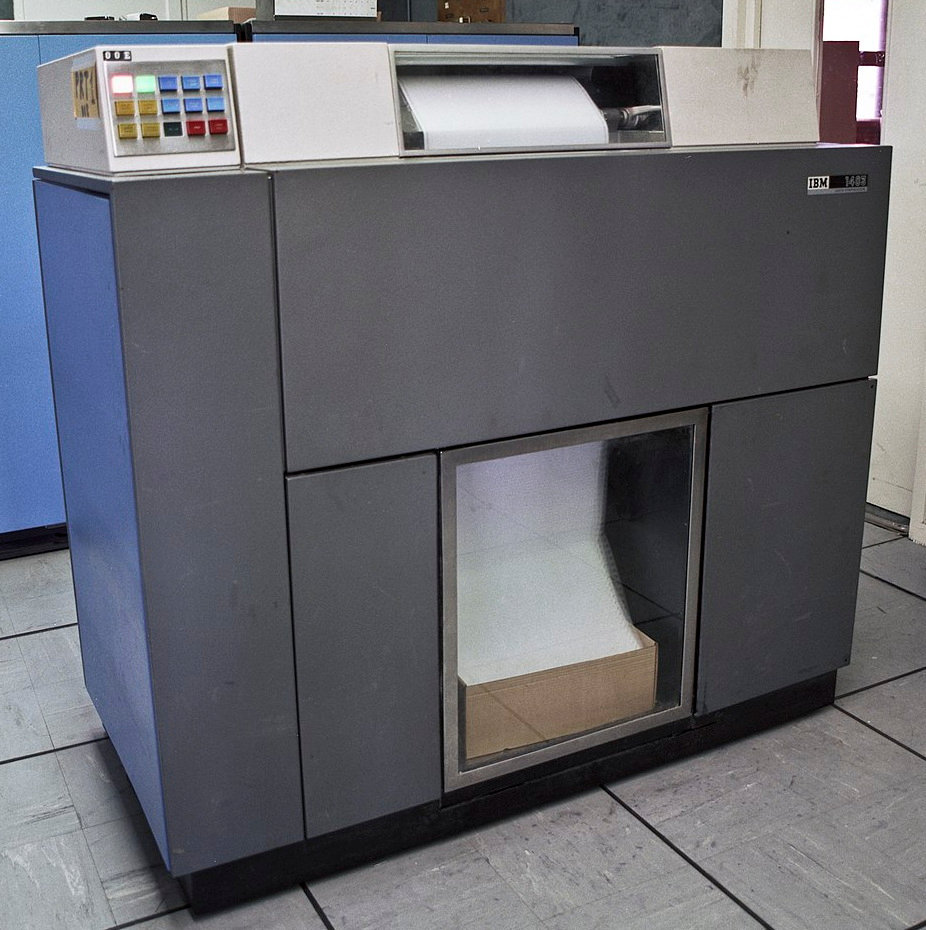 1970
IBM Printer
1970
IBM Printer
I did well at card reading so I moved up to handing printouts.
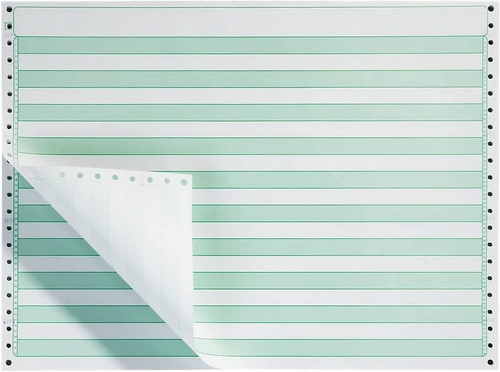 Computer
output was printed on large 11 x 14 inch, green striped paper that
came in a continuous fanfold, stack. [photo] The mainframe printer
was a cabinet the size of a large desk, five feet wide, four feet
deep and five feet tall, it was huge. In the front was a lower door
that held a box of computer paper, which then fed into the printer.
The printer printed an entire 14 inch wide line of characters with
one strike, then the paper would move up, it would print the next
line and so forth with the paper going over the top and then down
the back side where it would re-fanfold neatly into to a stack, well
most of the time anyway. The printer was fast, it could print a
whole 11x14 inch page in a few seconds. The printer was also
extremely loud, making a huge racket from the hammer strike for each
line. Even with the sound proofed cover closed it was hard to have
a conversation near the printer.
Computer
output was printed on large 11 x 14 inch, green striped paper that
came in a continuous fanfold, stack. [photo] The mainframe printer
was a cabinet the size of a large desk, five feet wide, four feet
deep and five feet tall, it was huge. In the front was a lower door
that held a box of computer paper, which then fed into the printer.
The printer printed an entire 14 inch wide line of characters with
one strike, then the paper would move up, it would print the next
line and so forth with the paper going over the top and then down
the back side where it would re-fanfold neatly into to a stack, well
most of the time anyway. The printer was fast, it could print a
whole 11x14 inch page in a few seconds. The printer was also
extremely loud, making a huge racket from the hammer strike for each
line. Even with the sound proofed cover closed it was hard to have
a conversation near the printer.
The first job as a student operator on the printer was on the output end. Each student’s deck of cards was called a computer job. Computer jobs be printed with a separator page between them with the student’s name on it. The printer operator would sit at the back of the printer, and after a number of jobs printed, would remove the stack, separate the individual jobs in the stack and then take them to the filing room to be filed for the students to pick them up. Generally, the printouts coming out re-fanfold into a nice pile but there were times when it did not and in a minute or two there would be a large pile of unfolded paper behind the printer which you would have to refold by hand. It wasn’t long before I was able to remove the printouts without having to pause the printer. When the stack of paper got to be two or three inches, I would slip my hand, like a karate chop, at just at the right moment after a job header page printed, separating the stack from the paper, and pulling it out all while the printer spewed out paper a hundred miles an hour.
With punch card processing and printer output mastered, the next level was magnetic tape, and I don’t mean little six inch reals of ¼ wide tape I used on my reel-to-reel tape recorder at home. There were six tape units along the back wall, six feet tall, three feet wide which used reals of ¾ inch wide tape, the size of LP records, oh wait you younger ones wouldn’t know about records, 12 inches in diameter. The tape computer operator sat in a chair next to an IBM computer terminal like I saw in Physics class which print out messages to mount a tape providing a tape name. The operator would locate the tape, put on the tape drive in the righthand position, thread a portion of the tape trough the machine to the permanent take up real on the left side. When all was ready, the start button was pressed and the tape would start moving, moving from the right real to the left empty real. Sometimes they would just smoothly go from one side to the other, other times they would go a ways, back up, go forward again, stutter back and forth, and so on. In the end they would rewind all the way to the starting reel and a message would print out on the computer terminal saying it was ready to be removed. It soon got boring, I would rather file printouts.
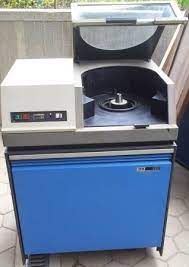 1970
IBM Disk Unit
1970
IBM Disk Unit
Then there were the magnetic disk units that were the size of a home
dishwasher. The disk units had removable disks that were in
cartridges that held ten stacked platters, fifteen inches in
diameter storing a whopping total of 7.25 megabytes. In comparison I
have a 64 gigabyte flash card for my camera that is the sized of my
little fingernail. The cartridges
 kind
of looked like a large cake cover with a handle in the middle. Like
the tapes, there was a terminal that printed messages telling the
operator to mount the disk, which would be put in the unit, twist
the handle, take the plastic top off then close the unit and press
start. The disk would then start spinning, faster, sounding like a
high speed clothes dryer crossed with a jet engine before it would
smooth out into a steady hum.
kind
of looked like a large cake cover with a handle in the middle. Like
the tapes, there was a terminal that printed messages telling the
operator to mount the disk, which would be put in the unit, twist
the handle, take the plastic top off then close the unit and press
start. The disk would then start spinning, faster, sounding like a
high speed clothes dryer crossed with a jet engine before it would
smooth out into a steady hum.
I enjoyed working at the computing center, it was fun and interesting. Even better, all the employees working there got a free unlimited account for computer time on the mainframe which I took advantage of. I begin writing more simple computer programs in FORTRAN, most notably was one for a word game. At the time the newspaper had a weekly contest, I don’t remember the details, but it involved words, so I wrote a FORTRAN program to solve the puzzle. The only problem was the program needed word, so I got out the dictionary and begin putting words on punch cards, hundreds of them. My deck of computer cards grew, two inches, four inches, six inches. My program first read a card with the parameters of the puzzle that week, then read the six inches of cards with words, and it solved the puzzle. It worked but there was a problem, it needed more words and let me tell you, there are a lot of words in the dictionary, and I hadn’t even entered a tenth of them.
Mainframes at the time only could run a few programs at a time, although it ran them really fast. The mainframe had a console which would show how many jobs were in the queue categorized by small, medium and large based on how much memory they used and a S, M or L on the control card of the deck of cards. Student programs, like the one I did for the FORTRAN class, were small and ran fast, the console would continuously print out messages about the jobs starting and ending. The medium and large jobs were fewer and ran longer. The senior operator would control the flow of jobs specifying how many small, medium and large jobs could run at once, and would adjust the type based on how many of each type were in the queue, one large and two medium, or two medium and four small and so on. When programs like the physics student with a dozen cases of punch cards ran, special arrangements would be made to run the programs in off hours as it would take the whole mainframe. sometimes for several hours which was not good for the students waiting for their computer program printouts.
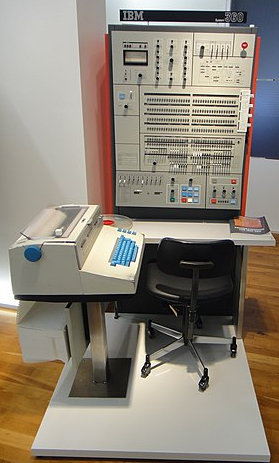 IBM
350 Console
IBM
350 Console
There were three senior computer operators, two men and a woman. The two men were country boys which seemed out of character for them to be working with computers, with their country accents and stories about hunting and fishing, I would have expected them to work on a farm, but they both were nice guys and were always willing to show me what they did, even on occasion letting me sit at the mainframe console and adjust the job queues. The woman operator, Jane, was nice, but she seemed a little scattered brain, and sometimes made mistakes. There was the time she forgot to turn on the water and the computer over heated. The university had upgraded the IBM 360 to an IBM 370 which produced so much heat that it had chilled water pumped though its circuit boards to cool it. In the back of the computer room was a double refrigerator sized unit that controlled the flow of chilled water to the mainframe from a water chiller outside the building. I usually worked afternoons but sometimes they would ask me to work on Saturday mornings. I came in early one Saturday morning arriving fifteen minutes early as I usually do, entered the computer room to find eerily quiet, everything was turned off. It was the strangest feeling, usually the computer room was filled with roar from all the computer equipment that you had to talk in a loud voice to be heard. It was quiet, everything had been turned off which surprised me, having only worked when the computer was on. I thought the computer stayed on all the time but actually the night shift shut it down each night at midnight. Soon Jane, the senior operator showed up and begin by turning on the mainframe which had many steps. The mainframe consisted of six or eight large cabinets situated around the computer. In addition to the main processor unit the size of three refrigerators, there were several cabinets that did things unknown to me. All the units had to be turned on in a certain order with the main processor being last. I walked with Jane as she went around tuning on each piece of equipment, then getting to the mainframe control panel, she turned on the main processor unit. All seemed good, the console started typing a series of messages about things I never heard of starting successfully. All looked well until about eight minutes later, a message printed out about the temperature being high, two minutes later the whole system shut down. Jane was in shock, but it didn’t take her long to figure out that she had forgot to turn the water on. She had powered on the water control unit but forgot to open the door and turn on the water valve. Not knowing if there was any damage to the mainframe, she called the IBM service hotline and within an hour an IBM service man shows up. Jane explained the situation, the service man spends an hour checking out everything, then powers the up mainframe, this time with the water turned on, and everything was fine.
 Margay
Cat
Margay
Cat
One of the more interesting operators, a guy nicknamed Beetle, a fellow student operator, who I became friends with. Beetle had no interest in computers, he just did it as a job. He was studying Herpetology, and was very into animals, particularly snakes. I went over to his house a couple of times, and he had made this really fantastic terrarium that had several snakes in it, but I didn’t see any because they until he pointed them out with them hidden in all the plants. Beetle also had a pet margay cat that he kept in one of his bedrooms that he showed me one day. He cracked open the bedroom door a couple of inches so I could look in, saying he didn’t want it to get out. I looked in the room was bare except for a couple of large branches going from the floor to the ceiling and there it was, sitting on one of the branches looking right at me. It looked like a small leopard but twice the size of a house cat.
Beetle told me he wanted to work a zoo after he graduated and I had long forgotten about it when, 25 years later, I ran across his name in a Washington Post newspaper article saying he worked in the reptile house at the National Zoo in Washington DC specializing in snakes. I called the National Zoo and asked to speak to him. When he answered I asked if he was the same person called Beetle who worked the University of Florida computing center back in 1970, he said he was and I told him who I was, but he didn’t remember me. I had hoped to get a behind the scenes tour of the snake exhibit, Oh, well.
Updated: 11-09-2022